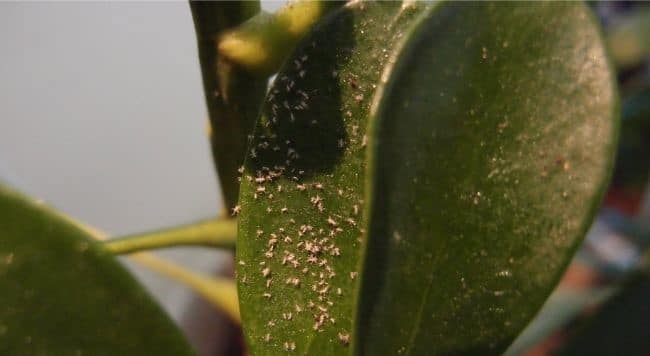It’s always so disappointing when you discover bugs on your houseplants. The beautiful plants you are nurturing are in danger and you must act quickly to save them. The good news is there are some great options to get rid of houseplant bugs naturally. This article will tell you everything you need to know about houseplant pests and the best ways to easily get rid of them without using any harmful pesticides.
How to get rid of houseplant bugs naturally? Use these 8 treatments to get rid of indoor plant pests naturally;
- Baby Shampoo Bug Spray
- Cooking Oil Spray
- Herbal Water Spray
- Dish Soap Spray
- Neem Oil
- Rubbing Alcohol
- Essential Oils
- Sticky Fly Paper
There’s no need to use pesticides or insecticides to rid your houseplants of bugs. Use my guide here to get rid of houseplant bugs naturally. This article will cover the following areas;
- The different types of bugs.
- Why treating naturally is better.
- How to make and use natural bug spray.
- How to make and use natural soap spray.
- Preventive tips to avoid bugs.
- Plants that are naturally resistant to pests.
Why Do My Houseplants Have Bugs?
Plants inside your home are just as prone to bugs and pests as outdoor plants. In fact, indoor plants often have more bugs than those in your garden. One of the reasons for this is that your indoor plants don’t have the assistance of insects to help control bug infestations, such as ladybugs.
Your plants are more vulnerable to bugs in the colder months. At this time of the year, plants go into their dormancy phase when they’re no longer growing. Houseplants are naturally weaker during dormancy.
Another reason why indoor plants are more susceptible to pests in colder months is that the temperature and room conditions are just right. During the mid-winter your home has less humidity and you’re probably heating indoors. Add less air circulation to those warm room temperatures and you have just the right environment for bugs to thrive.
How Bugs Get Into Your Home
You may be wondering how bugs get into your home in the first place. One day your plants look fine and the next day bugs have appeared without any warning. Here are some of the ways that houseplants can be infested with pests:
- Doors and windows – Bugs are quick to find the right environment for breeding. Open doors and windows are an easy entry point for pests.
- Bringing home new plants – New plants purchased at the gardening center present a risk for your other houseplants. Bugs may already have laid eggs on the leaves or in the soil of new plants without you being able to tell.
- Potting soil – Bugs and their eggs can be found in potting soil. For this reason, always buy top quality soil to reduce the risk of pests.
- Fresh produce or fresh cut flowers –Bugs can also be present in the fresh produce or flowers you buy.
- Outdoor plants – If you’re bringing a plant in from the outdoors when the weather starts to get colder, bugs may also come inside!
Different Types Of Bugs and Pests
Before you can start naturally treating bugs and pests, it helps to know what they are. When you can identify different bugs and pests you can come up with a plan of action to kill them… and take steps to ensure that they don’t return. Here’s a list of the most common bugs and pests that attack indoor houseplants.
Aphids
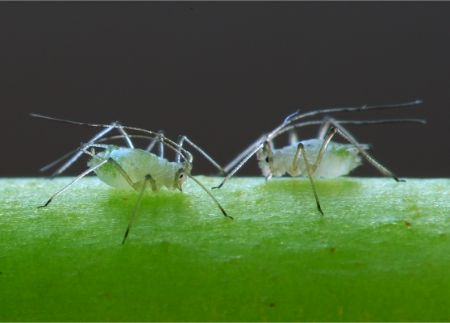
One of the most common of all houseplant pests are aphids. Typically found on the flower buds or the new growth of plants, aphids can be brown, green, or red. They can also be identified as white clustered specks on the soil.
Fungus Gnats
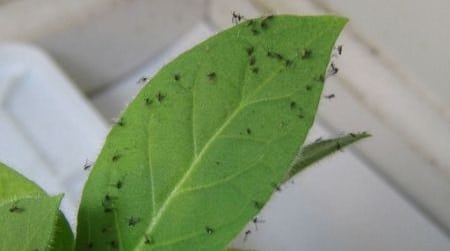
Fungus gnats look a lot like fruit flies floating around the plant. You’ll also find white or tiny black bugs on top of and in the plant soil.
Mealybugs
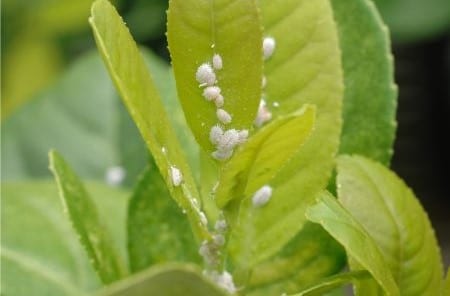
Mealybugs are evident if there’s white mildew or cotton sticking to the leaf branches and the stem of the plant. Mealybugs can also leave behind a sticky residue on the leaves or the area around the houseplant.
Scale
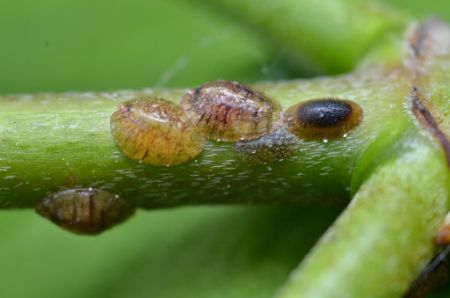
Scale can be identified when you find brown spots or crusty bumps on the stems and leaves of plants. You can easily remove these spots by carefully scraping, but there’s more to scale than brown spots – your indoor plants will have a sticky goo all over the leaves.
Spider Mites
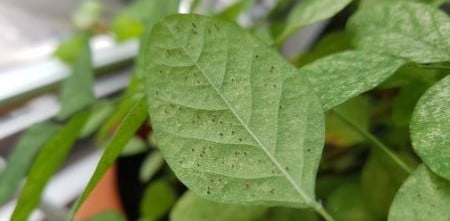
If your houseplant has spider mites, you’ll see either tiny spiders and/or spider webs on the stems and leaves of the plant.
Thrips
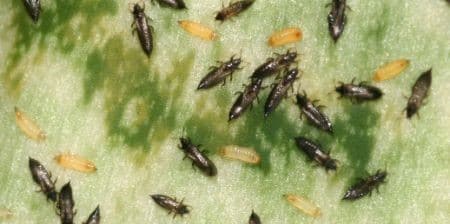
Thrips are tiny, thin insects that have small wings. They feed on the sap of plants by biting the leaves and stem. More commonly seen in outdoor plants, it’s not unusual for these pests to make their way indoors.
Whiteflies
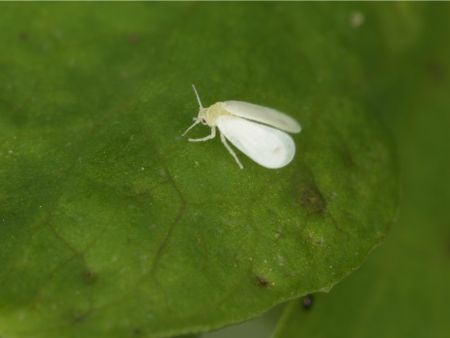
Whiteflies are small white bugs that fly around the plants. They can be hard to see until they’re disturbed and then you won’t be able to mistake these tiny flies as anything but a pest!
Natural Is Better
Anytime you find evidence of bugs on your houseplants you’ll need to quickly take action, so they don’t kill the plants or infest other plants in your home. When it comes to getting rid of bugs, natural methods are always best. There are some great home remedies for treating and controlling bugs.
Why is natural better? Using chemical pesticides on your plants can pose a health risk to you and your family. The last thing you want to do is treat indoor plants with a harsh chemical in such a confined space.
Another reason that natural is better is that many houseplants become resistant to chemical pesticides and build up an immunity. So not only are you using chemicals that are harmful to you and your family, these chemicals may be doing nothing at all when it comes to pest control.
Let me share some of my tips for natural pesticides to rid your plants of bugs.
Using Homemade Bug Spray
These homemade bug sprays can be used on a variety of different houseplants. Safe to use, they’re a much better option than using chemical bug sprays in your home.
Before using one of these sprays on any houseplant, do a test on the leaves first to see how the plant reacts. Wait for two to three days. If after this time the plant is “happy”, go ahead and use the spray over the entire plant.
Another tip to using natural bug sprays – after spraying keep the plant out of direct sunlight and hot rooms. The sun and heat, together with the spray, can burn the leaves.
Baby Shampoo Bug Spray
A spray made with baby shampoo works well to get rid of some bugs, such as aphids and whiteflies. Add 1 tablespoon of baby shampoo into a 4-ounce spray bottle. Fill to the top with water. Spray infected houseplants every two days with the spray.
After spraying and waiting for 4 hours, I rinse the plant with clear water using another spray bottle. The goal here is to cover the bugs for a few hours with the spray to treat and get rid of them. This spray doesn’t work well with plants that have bristly leaves or leaves with a wax coating.
Cooking Oil Pest Spray
An effective way to control aphids, spider mites, thrips, scale, and whiteflies is to use a spray made with cooking oil – you can use any oil that you have in your kitchen, including olive, canola, or sunflower.
Mix together 1 cup of oil with 1 tablespoon of a mild dish soap. Pour into a sealed container and store in a dark location when not using. To use, mix 2 cups of water with 4 teaspoons of the oil mix into a spray bottle. Mist the infected plant once, waiting a few days before applying again.
Herbal Water Spray
Herbs that have a strong scent can help to rid houseplants of spider mites, aphids, and other pests. Use one of the following fresh herbs, or a combination – basil, peppermint, lavender, sage, and rosemary. My preference is a combination of peppermint and rosemary.
Break apart and crush the herbs so that you have about ½ cup in total. Place the crushed herbs into a container with a lid. Add 3 cups of water and seal the container. Let steep for at least 24 hours. Strain the water into a spray bottle, throwing out the used herbs. Add ¼ teaspoon of mild dish soap to the water. Shake to mix before using. Then spray the entire plant once a day with the herbal spray. When not using, store the spray bottle in a cool and dark cupboard.
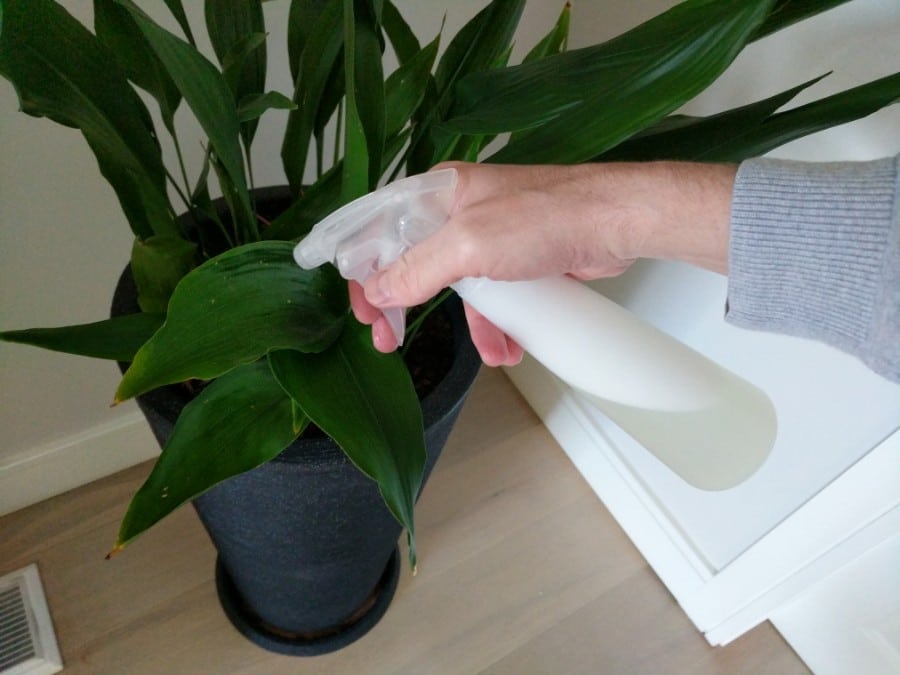
Using Dish Soap To Get Rid Of Houseplant Bugs Naturally
Dish soap sprays and washes can also be very effective in getting rid of houseplant pests naturally. Be sure to test before using one of these homemade soap sprays on your plants.
Mild Soap Spray
Always use a mild soap when treating your houseplants. Add 1 tablespoon of dish soap into a 1-quart spray bottle. Fill with tap water. This mix is a 2 percent solution that can treat and control some bugs, such as aphids, mealybugs, and spider mites.
Test one leaf before spraying the entire plant. If the leaf reacts by curling up or changing color, change to a 1 percent solution, adding just 2 teaspoons of mild soap. Test again. If the leaf still reacts, you’ll need to try a different natural method to get rid of bugs.
Castile Soap Bug Spray
Castile is a soap that naturally contains some fatty acids. These fatty acids are the main active ingredient found in many chemical insecticidal soaps. To make this spray, mix 1 tablespoon of castile soap with 1 quart of water to make a 2 percent solution, cutting back to 2 teaspoons for the 1 percent mix if needed.
To prevent a soap layer from building up on the plant, use hard water if you have it. Spray both the plant and the soil with the soap mix, waiting a full week to treat again if you don’t get rid of all the bugs the first time.
Neem Oil
Neem oil is safe to use and non-toxic for both humans and pets. Made from the seeds and fruits of an evergreen tree, neem is used by many professional indoor and outdoor gardeners to control bugs. Neem oil works well to control aphids and fungus gnats.
To use, dilute neem oil with water – 2 tablespoons of neem with 2 cups of water. Place into a spray bottle and spray over the entire plant, waiting at least a week before applying again.
Essential Oils Work Surprisingly Well To Get Rid Of Houseplant Bugs
Essential oils are both a great treatment and deterrent when it comes to treating bugs and pests. These oils are also good for treating fungal problems that many houseplants are susceptible to. Make these sprays out of essential oils as listed below to get of common bugs and pests.
- Aphids –cedarwood, spearmint, or peppermint
- Fungus gnats – spearmint or patchouli
- Mealybugs – cedarwood, peppermint, or lemongrass
- Spider mites – spearmint or peppermint
Add 10 drops in total into a 4-ounce spray bottle. Fill to the top with water to dilute. Spray on the leaves and stem of the plant to control and get rid of bugs.
If you find that your houseplants often have bugs, use a good essential oil spray regularly to control and deter these pests. Make by mixing three drops of each of the following oils in a 4-ounce spray bottle filled with water:
- Clove
- Peppermint
- Rosemary
- Thyme
Using Fly Paper To Get Rid Of Houseplant Bugs Naturally
Double-sided sticky fly paper is a great way of getting rid of fungus gnats, whitefly and aphids with minimal effort. Most fly paper is simply sticky paper that traps the insects when they come in contact with it. No pesticides are used, so these are a safe option.
The downside is they only work for adult bugs, so if they have a chance to reproduce before they get stuck, then you wont get rid of your pest problem easily. They don’t treat the soil or the rest of the plant, so I would generally only recommend this as a temporary measure.
Getting Rid Of Bugs In Plant Soil
Some pests, such as fungus gnats, are found in plant soil. If you see evidence of bugs, remove 1-inch of the soil and throw out. You can replace this soil with fresh soil or instead add a layer of fine sand instead. The sand will help prevent another infestation of bugs.
Another way to treat the soil is by soaking the soil with neem oil that has been diluted with a lot of water. Use 1 teaspoon of neem to 2 cups of water. Don’t over water or fertilize until you’re sure the pests are gone.
If you have any unused potting soil, store it in a tightly sealed container. Not only will it keep the bugs out, it will kill any bugs or larva that may be in the soil.
Getting Rid Of Pests On Plant Leaves
If your plants have pests, you’ll find a sure sign of them on the leaves of the plants. When spraying or washing the infected leaves, be as gentle as possible. Don’t over-spray to the point where the leaves are dripping.
Before spraying or washing, take the plant into a safe area so you don’t spray flooring, walls, or furniture at the same time. Place a layer of newspaper underneath the plant pot to catch any drips off the plant.
After spraying, leave the plant for a couple of hours so the spray has time to take action. You can then return the plant to its spot, checking daily to see if you’ve gotten rid of the bugs before treating again.
How To Get Rid Of Aphids Naturally
Tiny insects, aphids like the underside of plant leaves where they can feed off the sap of the plant. A few aphids on a plant won’t do much damage – the problem is that they quickly multiple and infest the plant. This can cause the leaves of the plant to become discolored and pale and can also stunt the growth of the plant.
To get rid of aphids, spray or wipe the leaves using a solution of dish soap and water. If the plant is heavily infested with aphids, and you’re keen to save the plant, pinch the top of the plant off at the stem and get rid of this part of the plant.
While the plant is recovering and growing again, avoid overwatering and stop fertilizing altogether. As the plant regrows, keep a close eye out for aphids and treat immediately with dish soap if you find any evidence of their return.
Ridding Plants of Fungus Gnats Naturally
Fungus gnats aren’t as damaging to the plant when they’re in their adult stage and flying around the plant like mosquitoes. It’s when fungus gnats are in the larva stage that they do their most damage.
The larva feed on the soil where they kill the roots of plants. When this happens the leaves will start to wilt and turn yellow. Plants that often are attacked by fungus gnats are flowering plants, such as gardenias and carnations.
The best solution to get rid of fungus gnats is to use a soap or neem oil spray on the soil. If there’s still evidence of the bug, you’ll need to repot the plant, gently cleaning the roots with water before repotting.
Once you’ve gotten rid of fungus gnats make sure the plant has good drainage and that you’re not over-watering. The soil should be allowed to dry out between watering to prevent an infestation of gnats.
Controlling and Getting Rid Of Mealybugs Naturally
Mealybugs thrive by feeding on the sap of plants. They have a pale white appearance and are typically found on the leaves, leaf joints, and stems of houseplants. As these bugs feed on the sap, the leaves will start to pale and yellow, curling slightly at the edges. The plant’s growth will also be stunted and if left untreated the plant will eventually die.
Use one of the natural sprays in this article to get rid of mealybugs. Another solution is to dip cotton swab in rubbing alcohol and gently rub the infected leaves. Once you’ve gotten the infestation of mealybugs under control, avoid over-fertilizing and over-watering the plant as mealybugs flourish in these conditions.
How To Rid Houseplants Of Scale Naturally
When your houseplant is infested with scale, the leaves will start to wilt and turn yellow. Eventually the plant will stop growing and your only option will be to replace it with a healthy plant.
As mentioned previously, you can rub scale off plants if there are just a few of these pests. But once the few become many, you’ll need something else to get rid of them. The best solution is to spray the plant with an herbal bug spray once a day. Another way to control and treat scale is by rubbing infected areas with a cotton swab dipped in a bit of rubbing alcohol.
Getting Rid of Spider Mites Naturally
The spider mite is a small pest that gathers in clusters underneath the plant leaves. These tiny spiders eat the fluids of the plant, leaving dots on the plant where they’ve eaten. Another problem with spider mites is that they spin webbing that sticks to the plant. Plants often infested with spider mites include English Ivy and flowering plants.
The best way to get rid of spider mites naturally is by spraying and cleaning the leaves of the plant with one of the natural bug sprays here. Once rid of mites, prevent their return by regularly dusting the leaves and misting with water. This stops spider mites from laying their eggs on the leaves.
How To Get Rid Of Whiteflies Naturally
Another pest that feeds on the sap of plants, whiteflies are usually found on the underside of leaves. They typically live in clusters and can quickly cause a plant to go from healthy to sick. The leaves will start to yellow and drop, and the plant will stop growing.
Treat whiteflies by spraying the plant with one of the natural sprays or soap sprays listed above. Once treated, a plant that has been infected once is more susceptible to another infestation, so monitor the plant closely for any returning whiteflies.
How To Prevent Bug Infestations
Some of your houseplants will be more vulnerable to bug problems than others. There are a few things that you can do to avoid bug infestations in the first place.
Inspect New Plants
When looking for new plants at the nursery or garden store, check them over carefully before buying and bringing them home. Look at the underside of the leaves as well as along each stem. Many pests enter your home by piggybacking their way in on new plants.
Isolate From Other Houseplants
When you bring home a new plant, leave it in a separate room on its own for at least a week. Keep a close eye on the entire plant to see if there are any signs of pests. If after a week the plant is bug-free, it’s ready to join your other plants.
Check Plants Before Bringing Indoors
If you have plants that summer outside in warm weather and come indoors for the winter, be sure to check them out carefully for pests. Many bugs that thrive outdoors will be just as happy inside with all your other houseplants.
Check Plants Regularly
It’s easier to rid plants of bugs when there are just a few of the pests than it is to treat an entire infestation. Get into the habit of regularly checking your plants and doing a full inspection. I recommend checking once a week – a quick scan may be all you need to treat bugs before they become a real problem.
Don’t Just Check Plants For Bugs
It’s not just your plants that need checking – a sign of bugs is a sticky residue not only on the plant but on the floor or surface below the plant. This residue is known as “honeydew” and is the excrement of bugs. If you find this honeydew in your home, it’s a sure sign that you have plant pests.
Best Houseplants For Repelling Bugs
One way to avoid bugs on your houseplants is to choose plants that are naturally resistant to pests. However, it’s important to note that some of these plants are toxic to small children and pets. If you do have children and pets, these toxic plants should be kept up high out of reach.
Snake Plant
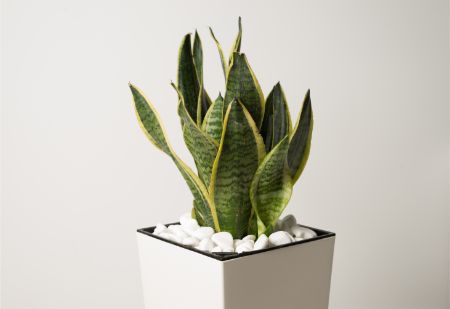
Also known as “mother-in-law’s-tongue”, the snake plant has leaves that are variegated in yellow, green, and cream colors. The leaves are leathery and tough, making them hard for bugs to attack. Read my guide to snake plant care here.
Coleus Blumei
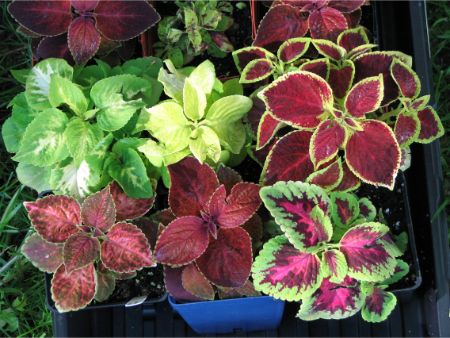
A coleus plant is beautiful, with its brightly colored leaves. It likes a lot of sun so does best in bright rooms with lots of windows. The leaves are tough and leathery, which is a great deterrent to bugs – they have a hard time getting through the outer leaf to the sap inside. While safe for children, the coleus can make your pet ill.
Basil And Other Herbs
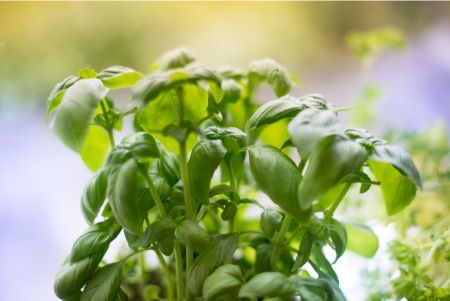
Most pests avoid the strong scent of herbs. This makes them ideal for growing indoors – and they brighten up any kitchen. Choose basil, mint, chamomile, and chives. All grow well on their own or you can bunch them together in one larger pot.
Jade Plant
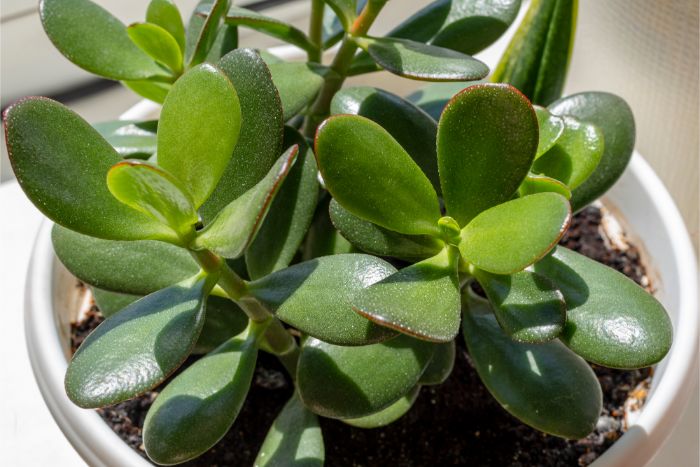
We’ve all had at least one jade plant – they come in a lot of different colors and varieties. Their leaves are thick and succulent. But it’s not the leaves that keep bugs away. It’s the toxic sap found within the leaves. While safe for kids, if you have pets, you’ll want to avoid this plant.
Common Questions:
I have a recurring problem with aphids and spider mites. Is the potting soil I’m using part of the problem?
When potting and repotting houseplants, always use sterile and fresh potting soil. This reduces the risk if any bugs or larva being present.
Can I spray my houseplants with vinegar to get rid of bugs?
Spider mites can be treated and controlled with vinegar. Use ¼ cup of apple cider vinegar with 1 cup of water. Add to a spray bottle and mix in 1 teaspoon of mild dish soap and 1 teaspoon of baking soda. Spray once a week to treat for mites.
I’ve had fungus gnats before and want to avoid them. What plants are most susceptible to this pest?
Fungus gnats thrive on indoor plants that need a lot of humidity and moisture. This includes African violets and orchids.
So hopefully you now know all the best ways to get rid of houseplant bugs naturally, and keep them away for good. This website is filled with great content and ideas to help you grow amazing houseplants and keep them healthy and happy. Head over to my houseplant section to read more.

